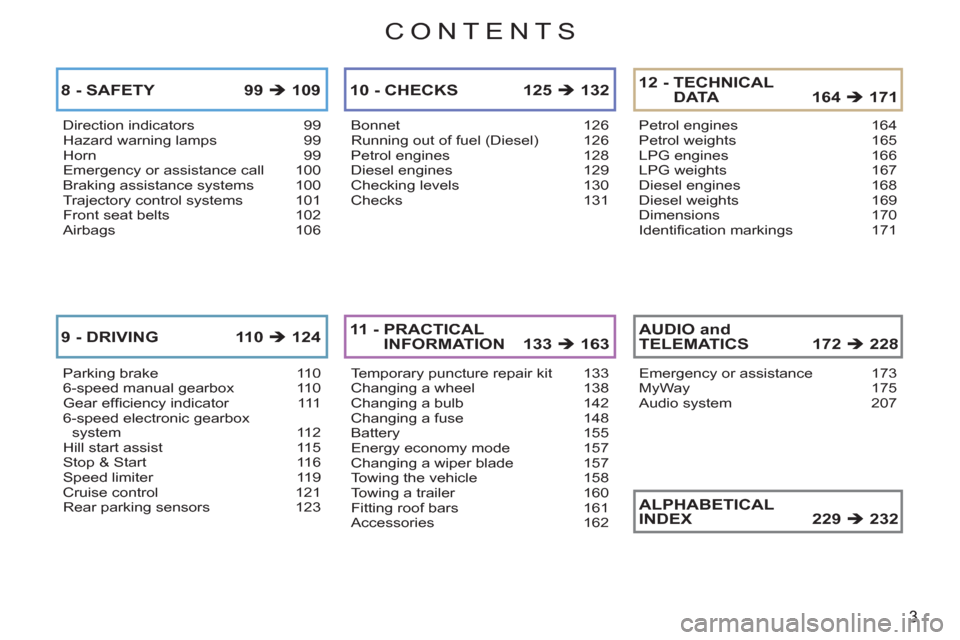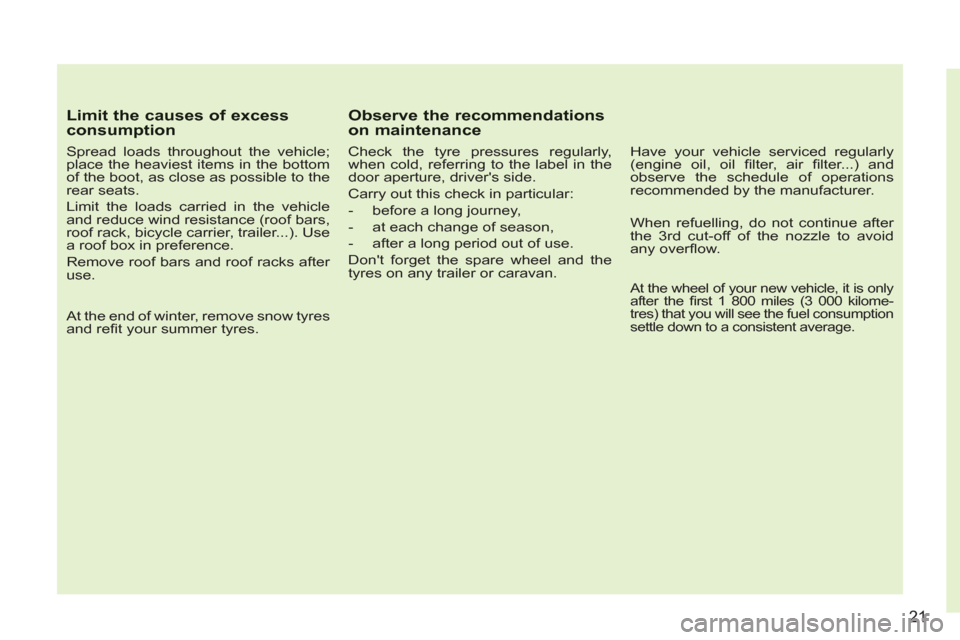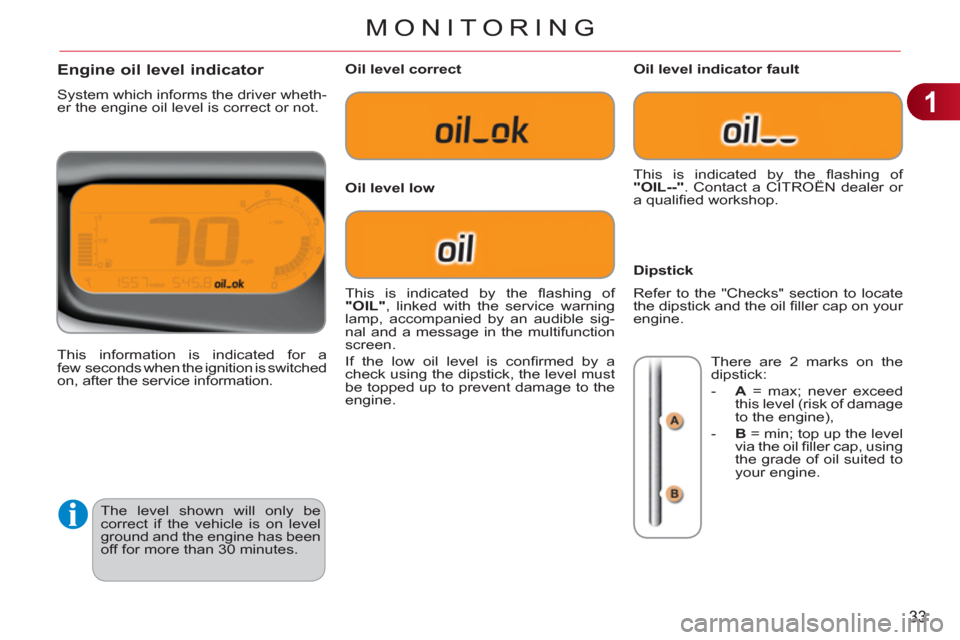check engine Citroen C3 PICASSO RHD 2012 1.G Owner's Manual
[x] Cancel search | Manufacturer: CITROEN, Model Year: 2012, Model line: C3 PICASSO RHD, Model: Citroen C3 PICASSO RHD 2012 1.GPages: 244, PDF Size: 8.31 MB
Page 5 of 244

3
CONTENTS
Direction indicators 99Hazard warning lamps 99Horn 99Emergency or assistance call 100Braking assistance systems 100Trajectory control systems 101Front seat belts 102Airbags 106
8 - SAFETY 99 �Π109
Parking brake 1106-speed manual gearbox 110Gear effi ciency indicator 1116-speed electronic gearbox system 112Hill start assist 115Stop & Start 116Speed limiter 119Cruise control 121Rear parking sensors 123
9 - DRIVING 110 �Π124
Bonnet 126Running out of fuel (Diesel) 126Petrol engines 128Diesel engines 129Checking levels 130Checks 131
10 - CHECKS125 �Î132
Temporary puncture repair kit 133Changing a wheel 138Changing a bulb 142Changing a fuse 148Battery 155Energy economy mode 157Changing a wiper blade 157Towing the vehicle 158Towing a trailer 160Fitting roof bars 161Accessories 162
11 - PRACTICAL
INFORMATION 133 �Î163
Petrol engines 164Petrol weights 165LPG engines 166LPG weights 167Diesel engines 168Diesel weights 169Dimensions 170Identifi cation markings 171
12 - TECHNICAL DATA164A�Î171
AUDIOandTELEMATICS172�Π228
ALPHABETICAL INDEX 229 �Π232
Emergency or assistance 173MyWay 175Audio system 207
Page 23 of 244

21
Limit the causes of excessconsumption
Spread loads throughout the vehicle;
place the heaviest items in the bottom
of the boot, as close as possible to the
rear seats.
Limit the loads carried in the vehicle
and reduce wind resistance (roof bars,
roof rack, bicycle carrier, trailer...). Use
a roof box in preference.
Remove roof bars and roof racks after
use.
At the end of winter, remove snow tyres
and refi t your summer tyres.
Observe the recommendations on maintenance
Check the tyre pressures regularly,
when cold, referring to the label in the
door aperture, driver's side.
Carry out this check in particular:
- before a long journey,
- at each change of season,
- after a long period out of use.
Don't forget the spare wheel and the
tyres on any trailer or caravan.
Have your vehicle serviced regularly
(engine oil, oil fi lter, air fi lter...) and
observe the schedule of operations
recommended by the manufacturer.
When refuelling, do not continue after
the 3 rd cut-off of the nozzle to avoid
any overfl ow.
At the wheel of your new vehicle, it is only
after the fi rst 1 800 miles (3 000 kilome-
tres) that you will see the fuel consumption
settle down to a consistent average.
Page 29 of 244

1
MONITORING
Warning lamps
When the engine is running or the vehicle is
being driven, the illumination of one of the fol-
lowing warning lamps indicates a fault which
requires action on the part of the driver. Any fault resulting in the illumination of a warning lamp must be investigat-
ed further by reading the associated message in the multifunction screen.
If you encounter any problems, do not hesitate to contact a CITROËN dealer
or a qualifi ed workshop.
Warning lamp
is on
Cause
Action/Observations
STOP
fi xed, alone or
associated with
another warning
lamp, accompanied
by an audible signal
and a message on
the screen.
The illumination of this
warning lamp is related
to a serious fault with the
braking system, the power
steering, the engine oil
pressure or the engine
coolant temperature. Stop as soon as it is safe to do so, as the engine
may cut out while driving.
Park, switch off the ignition and call a CITROËN
dealer or a qualifi ed workshop.
Service
temporarily,
accompanied
by an audible
signal and a
message on the
multifunction
screen. A minor fault has occurred
for which there is no
specifi c warning lamp. Identify the fault by reading the message shown
on the screen, such as, for example:
- engine oil level,
- screenwash level,
- remote control battery,
- state of the bulbs,
- saturation of the particle emission fi lter
on Diesel vehicles (see Checks - Particle
Emissions Filter).
For any other faults, contact a CITROËN dealer
or a qualifi ed workshop.
fi xed, accompanied
by an audible signal
and a message on the
multifunction screen.
A major fault has occurred
for which there is no
specifi c warning lamp. Identify the fault by reading the message shown
on the screen and contact a CITROËN dealer or
a qualifi ed workshop.
Braking
fi xed, associated
with the STOP
warning lamp. The braking system fl uid
level is too low. You must stop as soon as it is safe to do so.
Top up with brake fl uid recommended by
CITROËN.
If the problem persists, have the system checked
by a CITROËN dealer or a qualifi ed workshop.
+
fi xed, associated
with the STOP and
ABS warning lamp. The electronic brake force
distribution (EBFD) system
has a fault. You must stop as soon as it is safe to do so.
Have it checked by a CITROËN or a qualifi ed
workshop.
Page 30 of 244

1
28
MONITORING
Warning lamp
is on
Cause
Action/Observations
Anti-lock
Braking
System
(ABS)
fi xed. The anti-lock braking
system has a fault. The vehicle retains conventional braking.
Drive carefully at reduced speed and contact a
CITROËN dealer or a qualifi ed workshop without
delay.
Dynamic
stability
control
(ESP/ASR)
fl ashing. The ESP/ASR regulation is
active. The system optimises traction and improves the
directional stability of the vehicle.
fi xed. Unless it has been
deactivated (button pressed
and its indicator lamp on) the
ESP/ASR system has a fault. Have it checked by a CITROËN or a qualifi ed
workshop.
Engine
autodiagnosis
system
fl ashing. The engine management
system has a fault. Risk of destruction of the catalytic converter.
Have it checked by a CITROËN dealer or a
qualifi ed workshop.
fi xed. The emission control
system has a fault. The warning lamp should go off when the engine
is started.
If it does not go off, contact a CITROËN dealer or
qualifi ed workshop without delay.
Low fuel level
fi xed. When it fi rst comes on there
remains approximately
5 litres of
fuel
in the tank. You must refuel as soon as possible to avoid
running out of fuel.
This warning lamp will come on every time the
ignition is switched on, until a suffi cient addition
of fuel is made.
Fuel tank capacity: approximately 50 litres
(petrol) or 48 litres (Diesel); depending on
version: approximately 30 litres (petrol or Diesel).
Never continue to drive until you run out of fuel
as this could damage the emission control and
injection systems.
Page 32 of 244

1
30
MONITORING
Warning lamp
is on
Cause
Action/Observations
Airbags
temporarily. This lamp comes on for
a few seconds when you
turn on the ignition, then
goes off. This lamp should go off when the engine is
started.
If it does not go off, contact a CITROËN dealer or
a qualifi ed workshop.
fi xed. One of the airbag or seat
belt pretensioner systems
has a fault. Have it checked by a CITROËN dealer or
a qualifi ed workshop.
Front seat belt
not fastened/
unfastened
fi xed then
fl ashing
accompanied
by an
increasing
audible signal. The driver and/or the front
passenger has not fastened
or has unfastened their seat
belt.
Pull the strap then insert the tongue in the buckle.
Rear seat belt
not fastened/
unfastened
fi xed then
fl ashing
accompanied
by an audible
signal.
One or more rear
passengers have
unfastened their seat belt.
Power
steering
fi xed. The power steering has
a fault. Drive carefully at reduced speed.
Have it checked by a CITROËN dealer or
a qualifi ed workshop.
Page 35 of 244

1
33
MONITORING
The level shown will only be
correct if the vehicle is on level
ground and the engine has been
off for more than 30 minutes.
Engine oil level indicator
System which informs the driver wheth-
er the engine oil level is correct or not.
This information is indicated for a
few seconds when the ignition is switched
on, after the service information.
Oil level correct
Oil level low
Oil level indicator fault
Dipstick
This is indicated by the fl ashing of
"OIL"
, linked with the service warning
lamp, accompanied by an audible sig-
nal and a message in the multifunction
screen.
If the low oil level is confi rmed by a
check using the dipstick, the level must
be topped up to prevent damage to the
engine. This is indicated by the fl ashing of
"OIL--"
. Contact a CITROËN dealer or
a qualifi ed workshop.
Refer to the "Checks" section to locate
the dipstick and the oil fi ller cap on your
engine.
There are 2 marks on the
dipstick:
- A
= max; never exceed
this level (risk of damage
to the engine),
- B
= min; top up the level
via the oil fi ller cap, using
the grade of oil suited to
your engine.
Page 48 of 244

3
46
COMFORT
The condensation created by
the air conditioning results in a
discharge of water under the ve-
hicle which is perfectly normal.
The air conditioning system does
not contain chlorine and does not
present any danger to the ozone
layer. RECOMMENDATIONS FOR VENTILATION AND AIR CONDITIONING
In order for these systems to be fully effective, follow the guidelines on operation
and maintenance below:
�)
If the interior temperature remains very high after the vehicle has been
parked in the sun for a considerable time, fi rst ventilate the passenger
compartment for a few minutes.
Place the air fl ow control at a suffi cient level to provide an adequate renewal
of air in the passenger compartment.
�)
To obtain an even air distribution, take care not to obstruct the exterior air
intake grilles located at the base of the windscreen, the nozzles, the vents
and the air outlets, as well as the air extractor located in the passenger
compartment on both sides of the rear shelf.
�)
Do not cover the sunshine sensor, located on the dashboard (behind
the instrument panel); this is used for regulation of the air conditioning
system.
�)
Operate the air conditioning system for 5 to 10 minutes, once or twice a
month to keep it in good working order.
�)
Ensure that the passenger compartment fi lter is in good condition and have
the fi lter elements replaced regularly (refer to the "Checks" section).
We recommend the use of a combined passenger compartment fi lter.
Thanks to its second special active fi lter, it contributes to the purifi cation
of the air breathed by the occupants and the cleanliness of the passenger
compartment (reduction of allergic symptoms, bad odours and greasy
deposits).
�)
To ensure correct operation of the air conditioning system, you are also
advised to have it checked regularly.
�)
If the system does not produce cold air, do not use it and contact a
CITROËN dealer or a qualifi ed workshop.
When towing the maximum load on a steep gradient in high temperatures,
switching off the air conditioning saves engine power and so improves towing
capacity.
Page 63 of 244

4
61
ACCESS
Lost keys
Visit a CITROËN dealer with the vehicle's registration document, your
personal identifi cation documents and if possible the key code label.
The CITROËN dealer will be able to fi nd the key code and the transponder
code required to order a new key.
Do not throw the remote con-
trol batteries away, they contain
metals which are harmful to the
environment.
Take them to an approved col-
lection point.
Remote control
The high frequency remote control is a sensitive system; do not operate
it while it is in your pocket as there is a possibility that it may unlock the
vehicle, without you being aware of it.
Do not repeatedly press the buttons of your remote control out of range and
out of sight of your vehicle. You run the risk of stopping it from working and
the remote control would have to be reinitialised.
The remote control does not operate when the key is in the ignition switch,
even when the ignition is switched off, except for reinitialisation.
Locking the vehicle
Driving with the doors locked may make access to the passenger compart-
ment by the emergency services more diffi cult in an emergency.
As a safety precaution (with children on board), remove the key from the
ignition switch when you leave the vehicle, even for a short time.
Anti-theft protection
Do not make any modifi cations to the electronic engine immobiliser system;
this could cause malfunctions.
When purchasing a second-hand vehicle
Have the pairing of all of the keys in your possession checked by a
CITROËN dealer, to ensure that only your keys can be used to open and
start the vehicle.
Page 70 of 244

4
68
ACCESS
Additions of fuel must be of at
least 5 litres to be registered by
the fuel gauge.
The key cannot be removed
from the lock until the cap is re-
fi tted.
Opening the fi ller cap may create
a noise caused by an inrush of
air. This vacuum is entirely nor-
mal and results from the sealing
of the fuel system.
FUEL TANK
Fuel tank capacity: approximately
50 litres (petrol) or 48 litres (Diesel);
(Depending on version: approxi-
mately 30 litres (petrol or Diesel)).
Low fuel levelFillin
g
A label affi xed to the inside of the fl ap
reminds you of the type of fuel to be
used depending on your engine.
When the low fuel level is
reached this warning lamp
comes on in the instrument
panel. When it fi rst comes on
there remains approximately
5 litres
of fuel in the tank.
You must refuel as soon as possible to
avoid running out of fuel.
If you run out of fuel (Diesel), refer also
to the "Checks" section. To fi ll the tank safely:
�)
the engine must be switched off,
�)
open the fuel fi ller fl ap,
�)
insert the key in the cap, then turn it
to the left,
�)
remove the cap and hook it onto
the clip located on the inside of the
fl ap,
�)
fi ll the tank, but do not continue
after the 3rd cut-off of the pump
;
this could cause malfunctions.
When you have fi lled the tank:
�)
put the cap back in place,
�)
turn the key to the right, then remove
it from the cap,
�)
close the fl ap.
With Stop & Start, never refuel
with the system in STOP mode;
you must switch off the ignition
with the key.
Page 72 of 244

4
70
ACCESS
MISFUEL PREVENTION(DIESEL) *Operation
It remains possible to use a fuel
can to fi ll the tank; this must be
done slowly.
In order to ensure a good fl ow of
fuel, do not place the nozzle of
the fuel can in direct contact with
the fl ap of the misfuel prevention
device.
This tool will become available during
the year. Mechanical device which prevents fi lling
the tank of a Diesel vehicle with petrol. It
avoids the risk of engine damage that can
result from fi lling with the wrong fuel.
Located in the fi ller neck, the misfuel
prevention device appears when the
fi ller cap is removed.
When a petrol fi ller nozzle is introduced into
the fuel fi ller neck of your Diesel vehicle, it
comes into contact with the fl ap. The sys-
tem remains closed and prevents fi lling.
Do not persist but introduce a Diesel
type fi ller nozzle.
Travelling abroad
As Diesel fuel pump nozzles
may be different in other coun-
tries, the presence of the misfuel
prevention device may make re-
fuelling impossible.
Before travelling abroad, we
recommend that you check with
the CITROËN dealer network,
whether your vehicle is suitable
for the fuel pumps in the country
in which you want to travel.
*
According to country of sale.
Deactivation
Before refuelling using non-standard
Diesel fuel nozzles (present in some
countries), a tool allows you to temporar-
ily disable the misfuel prevention device.
Use
�)
Introduce the tool into the fi ller neck
as far as the handle will allow.
�)
Remove the tool completely.
�)
Fill with fuel.
The misfuel prevention device
will be activated the next time a
standard nozzle is used.